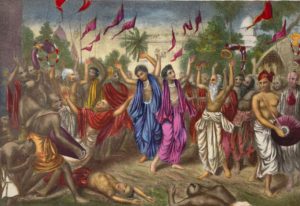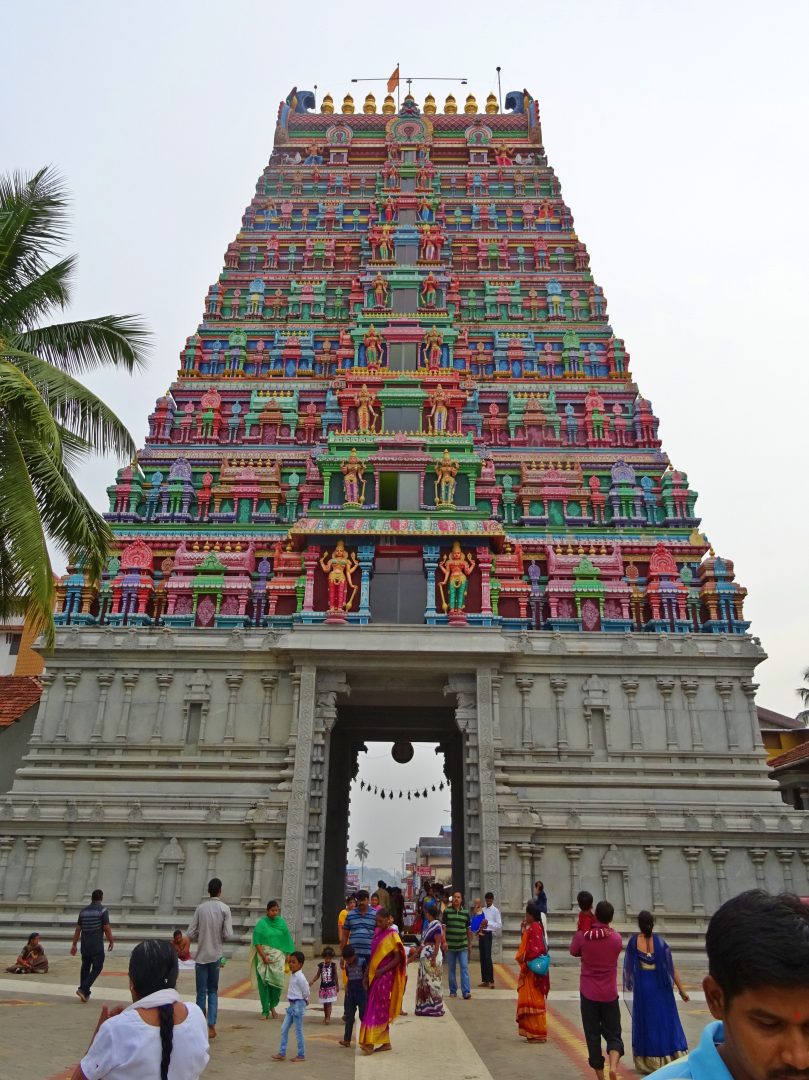In Vedanta darsana there are three main schools: Advaita, Visistadvaita and Dwaita. These schools interpret the Upanishads, Brahman-Sutras and Gita (together called prasthana-traya) and come to different final conclusions regarding the ultimate truth. There are three things that need to be understood – The individual (jiva), The world (jagat) and God (Iswara/Brahman).These are presented in chronological order below.
Advaita
Sri Adi Sankaracharya promoted Advaitha philosophy (6 BC). This philosophy was more influenced by Upanishad-words like ‘Ekameva Advitiam’. The reason for vedic religion being alive today without being wiped out by Buddhism, is all attributed to this school. This is most widely accepted school in India and many spiritual masters like Swami Vivekananda, Sri Rama Krishna, Ramana Maharshi, Aurobindo suggested and support it. Advaita teaches “Brahma Satyam, Jagat Mithya, Jivo Brahmaiva na aparah”. Means, Brahman alone is Real, The world is not real. And Jiva and Brahman are the same. Advaita teaches that, the world we see and transact is, in reality, a projection of Brahman. Brahman is the partless, all-pervading, infinite consciousness, knowledge and bliss.”World is not real (mithya) means that the world has no independent existence of its own. The individual is not what he identifies himself with. But in essence an individual is this consciousness itself. Due to the play of Maya/Avidya an individuality of a jiva arises.
The mechanical repetition of I am Brahman(Aham Bramhasmi) is a sorry substitute for intelligent devotion. Hence the emphasis on Bhakti in theistic systems, including vaisnava, Saiva and Sakthi schools grew in this time (meaning Ramanujacharya’s time). Puranas also gained importance apart from PrasthanaTraya.
Visistadvaita (VA)
Sri Ramanajucharya promoted this school(1027 AD). This Advaitha or non-dualism, with a qualification (visesa), admits plurality, since the supreme spirit subsists in a plurality of forms as soul and matter. It is therefore called Visista Advaitha or Qualified Non Dualism. VA holds that Jagat, the world has an independent existence of its own (prakriti)and is real and forever subservient to Brahman. Individual Jivas are same as Brahman qualitatively but not fully. Jivas are parts of Brahman. VA teaches Jivas are like individual sparks of fire where as Brahman is the original fire (as an example). While advaita teaches that Brahman has no qualities (as there is nothing other than Brahman), VA tells that Brahman has infinite qualities. In between there were two Telugu Bramhins Nimbarka (Dwaitha Adwaitha) and Vallabha who propagated a slightly different versions of VA.
Dvaitha
Sri Madhvacharya also known as PoornaPrajna and Anandatirtha promoted this school (1199 AD). Most of his works were influenced by Ramanujacharya. Dwaitha teaches that Jiva, Jagat and Brahman are all real and are completely separate entities. It identifies brahman with Narayana and is endowed with all auspicious qualities. Jivas are eternally being subservient to Brahman and can never themselves become Brahman. The main differences between Dwaitha and VA are 1) VA says individual souls are similar in their natural essence,Dwaitha says they are different 2) Madhva denies that Brahman is the material cause, which VA admits; Madhva says universe is not body of God 3) VA says there are no souls disqualified for salvation and there are no differences in the enjoyment of bliss of freed souls.
Chaitanya Movement
Influenced by times of Jayadeva Geetha Govindam and Chandidas (14 th century) there came Chaitanya Maha Prabhu a great vaishnava preacher (15th century, Radha Krishna Cult, Bengal,Bihar) though contradicting orthodox community by accepting muslims (eg.Haridasa), Rupa and Sanathana Goswami as disciples spread this cult. Jiva Goswami (16 th century) and Baladeva furnished the Philosophical basis. It derives its disciplic succession from Madhvacharya but a bit modified philosophy and named “inconceivably (achintya) dualistic (bheda) and monistic (abheda)”.
 Article is not biased to any school of philosophy in the description. It is not preference of any one to accept a particular school of philosophy. Every person has to first have a basic knowledge of the teachings of the scriptures. The same truth that is told in scriptures can be interpreted in several ways. Based on one’s spiritual development and basic nature of the person one has to come to an understanding of the Eternal Truth by using his own discretion.
Article is not biased to any school of philosophy in the description. It is not preference of any one to accept a particular school of philosophy. Every person has to first have a basic knowledge of the teachings of the scriptures. The same truth that is told in scriptures can be interpreted in several ways. Based on one’s spiritual development and basic nature of the person one has to come to an understanding of the Eternal Truth by using his own discretion.
References: 1) Kanakaraju 2) Yugal Kishore Das (ISKCON) 3) THE INDIAN PHILOSOPHY, Sarvepalli Radha Krishnan 4) Sankara Darshanam, Acharya Vijayam, Viswanathamaiah Vinjamuri(my father)






